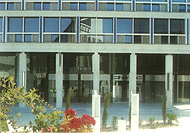projects for Athens
by
VITTORIO MAZZUCCONI
in collaboration with J.Vikellas
Athens 1983 - 87
Office Complex and Commercial Centre
12. Kifissia Avenue, Paradissos Amaroussion
Diethnis Techniki SA
| BACK | HOMEPAGE | ARCHITECTURE | PAINTING | PHILOSOPHY | FOUNDATION |
| B.1.5.2.1 |
| ATHENA projects for Athens by VITTORIO MAZZUCCONI in collaboration with J.Vikellas |
The new Agora (1/4) Athens 1983 - 87 Office Complex and Commercial Centre 12. Kifissia Avenue, Paradissos Amaroussion Diethnis Techniki SA |

|
|
The concept behind the new Agora projet is that of giving to an Offices and Commercial Center program the ideal and the inspiration of bringing the Agora (meeting-place for the community, heart of the ancient Athens) back to life. Thus, differently from other commercial areas, developed on the same street (the Kifissias Avenue), we have a marble square surrounded by porticos, which is situated a little apart from the street, with the intent of underlining the project's magical quality. One of the complex's buildings is inspired to the ancientStoa of Attalo, whose forms have been translated in a contemporary architectural language. Another building has simple mirror glass facades which act as a screen on which the image of the Teseion "materialises": it is the most ancient Temple of Athens, which may still be seen in the old Agora. Its facade appears by means of a reflecting effect, while the building is covered by a sail, secretly and esoterically inspired to the ancient temple. So the idea of the Arch comes back to the surface in Athens as it already had in the past, animating all of Mazzucconi's projects. in Paris (see Lutetia: Les Halles, l'Arche des Neiges, Nancy etc) and Florence (The Dawning City) As usual, this idea is associated to that of the temple. Finally, there is a village, composed by numerous small shops, partly internal and partly outside the temple, which provide a filter that separates the avenue from the square. The complex has a clearly identifiable perimeter thanks to the streets and property boundaries, that the project inter- prets as an authentic defensive wall. This reference to the city walls is expressed with destructured fragments. |